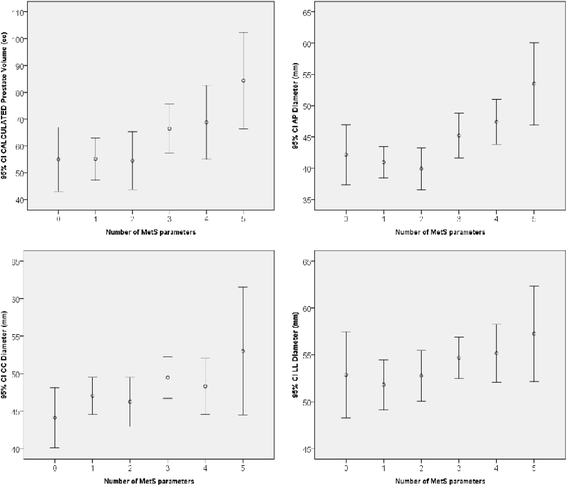Benign prostatic enlargement can be influenced by metabolic profile: results of a multicenter prospective study
- PMID: 28376747
- PMCID: PMC5379726
- DOI: 10.1186/s12894-017-0211-9
Benign prostatic enlargement can be influenced by metabolic profile: results of a multicenter prospective study
Abstract
Background: In last years Metabolic Syndrome (MetS) has been closely associated to Benign Prostatic Enlargement (BPE) Aim of our study is to evaluate the effect of MetS and each single MetS parameter on prostate growth in men surgically treated for BPE.
Methods: Overall, 379 men were prospectively enrolled in two tertiary referral centers. Calculated prostate volume (PV) was measured with transrectal US defining the antero-posterior (AP), the cranio-caudal (CC) and the latero-lateral (LL) diameters through the ellipsoid formula, while raw PV was calculated by suprapubic US. MetS was defined according to the NCEP-ATPIII criteria.
Results: One-hundred and forty men (36.9%) were affected by MetS. The number of MetS parameters (0 to 5) and the presence of MetS were correlated with the calculated PV. The number of MetS parameters were also directly related to increasing prostate diameters. At the binary logistic regression, MetS resulted associated to high (>60 cc) raw and calculated PV. Moreover, multivariate analysis suggested that AP diameter was mainly correlated with HDL cholesterol (r:-0.3103, p = 0.002) CC diameter with triglycerides (r:-0.191, p = 0.050) and LL diameter with systolic blood pressure (r:0.154, p = 0.044). However, at the binary logistic regression, only low HDL Cholesterol was the main determinant for the enlargement of all diameters and consequently of the whole PV.
Conclusions: Metabolic factors, specially dyslipidemia, could play a central role in the pathogenesis and progression of BPE/LUTS. Interventional studies are needed to evaluate the impact of early treatment of dyslipidemia on progression of LUTS/BPH.
Keywords: Benign prostatic enlargement; Benign prostatic hyperplasia; Dyslipidemia; Lower urinary tract symptoms; Metabolic syndrome.
Figures



References
-
- Berry SJ, Coffey DS, Walsh PC, Ewing LL. The development of human benign prostatic hyperplasia with age. J Urol. 1984;132:474–9. - PubMed
-
- Vignozzi L, Rastrelli G, Corona G, Gacci M, Forti G, Maggi M. Benign prostatic hyperplasia: a new metabolic disease? J Endocrinol Invest. 2014;37(4):313–22. - PubMed
-
- Corona G, Rastrelli G, Morelli A, Vignozzi L, Mannucci E, Maggi M. Hypogonadism and metabolic syndrome. J Endocrinol Invest. 2011;34(7):557–67. - PubMed
Publication types
MeSH terms
LinkOut - more resources
Full Text Sources
Other Literature Sources
Medical

